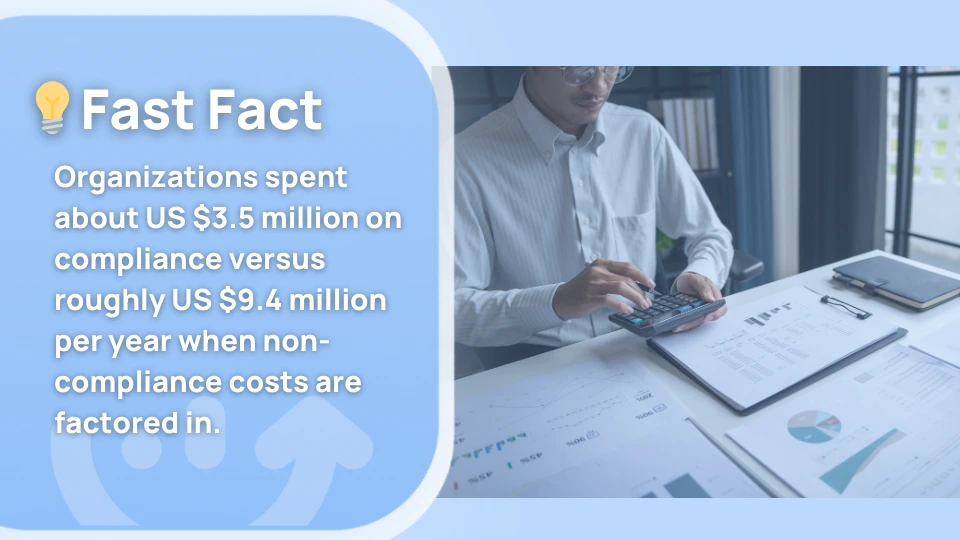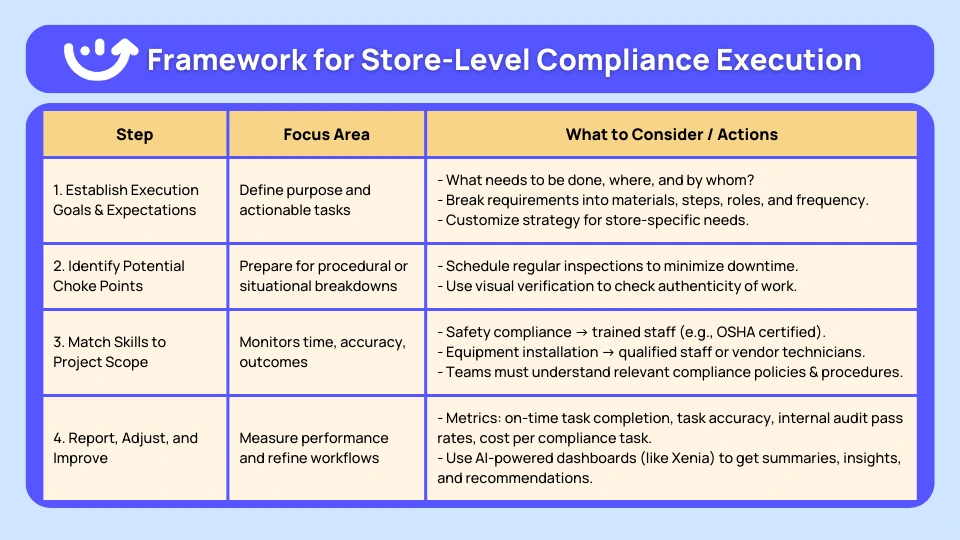Penalties, fines, legal disputes, and shutdowns; compliance has always been a part of operational execution, but mostly driven by fear. However, modern times have changed how retail stores view their compliance and regulatory needs.
Compliance, which was often done to avoid fines or shutdown orders, has now become an integral part of operations.
And it's no longer just about submitting paperwork, but also about enhancing risk management and improving processes. And digital audit tools have made this shift possible.
Digital retail audit management not only ensures your work process complies with the safety and quality standards, but it also helps enhance overall operational efficiency. In this blog, let's find out how that actually happens.
.svg)

Priced on per user or per location basis
Available on iOS, Android and Web
The Current State of Compliance and Store Operations
Organizations are well aware of the risks and adverse impacts that can occur if compliance is not integrated into their operations. So, it is unlikely that a company doesn't already have a compliance strategy.
However, even with compliance strategies in place, the challenge lies in executing them effectively.

Let's see what the current state of existing compliance and store operations is:
- Teams are aware that compliance needs to be maintained, but nobody is accountable. The compliance responsibilities and tasks are not assigned to the right teams. Although policies exist, there are no assigned roles, no completion criteria, and no tasks allocated.
- The organizational goals or business objectives don't cover compliance strategies.
- Compliance programs, designed for auditors and regulatory requirements, are often unrealistic to achieve in real-time for frontline teams.
- The compliance strategies aim to comply with regulations & collect evidence, but they are not really reducing safety risks. For instance, your team might be completing countless checklists, but they are not effective in decreasing theft encounters.
- The policies are difficult to understand or unclear, with technical jargon and complex work processes, making procedures challenging for workers to execute.
- Compliance programs are well-designed, but the company lacks adequate resources to execute them effectively.
- Your team may not fully understand the compliance requirements or may not have received proper training for them.
How Digital Audit Tools Transform Compliance Management
The gap is between having a compliance strategy and executing it. Supported by a study conducted by PwC, where 85% respondents agreed that the compliance requirements have become more complex.
The business models and operations are interconnected, and with data challenges with high volume and fragmentation, it becomes challenging to establish consistent compliance.
About 90% of firms facing the same problems as yours are adopting AI-compliance policies, which help execute compliance plans into practical, daily actions. Let's understand how:
How Digital Retail Audit Management Drives Compliance Excellence
1. Audit Planning and Scheduling
Retail compliance software, with AI assistance, enables you to create digital checklists for audits in seconds.
The digital checklists offered by Xenia integrate weighted scoring, which gives you a cumulative score for every audit you perform, indicating the level of compliance.
With the audit scores, you can compare the performance of your compliance tasks to industry standards, gaining insight into the efficiency of your work processes.
Check some of the most used retail checklists for audits:
- Retail Store Maintenance Checklist
- Retail Mystery Shopper Checklist
- Retail Cleaning Checklist
- Retail Store Pre-Opening Checklist
- Retail Employee Training Checklist

2. Audit Workflow Automation
You can also incorporate conditional logic and workflows, where every failed answer, which could potentially be a risk factor, initiates corrective workflows, such as triggering alerts or assigning a maintenance audit.
Managers can automatically push bulk tasks to all locations using the compliance management systems.
Automated task assignment is useful for recurring tasks, like regular internal audits or certificate collection, ensuring they don't get missed with minimal time consumption.
3. Retail Task Management: Assign Role-based Tasks
Digital compliance software enables managers to manage task orders with specified responsibilities, with clear ownership and accountability.
For example, auditors are allotted compliance checklists (such as HIPAA and OSHA), whereas IT teams review user access and system logs against SOX or ISO 27001 requirements.
For every task, you can:
- Set priority levels (Low, Medium, High, or Critical)
- Link locations or assets, if needed
- Attach digital checklists, forms, or SOPs
- Assign tasks based on users, teams (e.g., operations, merchandising, or HR teams), locations, or rules
- Create ad hoc tasks
- Photo-based task creation
- Automated and real-time task progress tracking (Open, In Progress, On Hold, Completed)
- Define specific time windows for task completion
With retail operations software, you are not just producing paperwork, but also ensuring the compliance strategies are working, making workplaces safer, and reducing actual risks.
For this, you need to ensure the tasks are happening, not just being ticked off in the logs. To do so, digital audit platforms let you collect evidence for every task in the following ways:
- Workers can report task completion, along with location tags or timestamps, to ensure accurate tracking and record-keeping.
- Digital signatures offer accountability for individual tasks that the team members perform.
- With photo and video attachments, workers can provide proof of completed work orders.
- By customizing digital forms for compliance tasks, the managers can track all the needed information.
- With a central data management platform, the systems automatically capture data in real-time.

4. Transparency with Real-time Store Insights
Compliance management software gives you a custom dashboard, where you can view and monitor the progress of real-time updates (like whether the reported incidents have been escalated or not & progress bars for different compliance tasks). Most software comes with mobile accessibility and offline functionality, which enable the teams to access all the mobile audit tools from their devices.
5. Incident Reporting and Management
Incident reporting is a crucial part of compliance management, and digital audit tools enable teams to make the workplace safer and more secure.
With instant notification and alert systems, workers can immediately report incidents, such as theft, missing items, safety hazards, missed inspections, or any other issue that could potentially become a serious problem.
Eg: To achieve merchandising compliance, some of the advanced retail execution platforms can compare real-time images of products or goods with the original visual blueprint. If any item is incorrectly displayed or goes missing, the store managers are automatically alerted.
- The digital audit tools centrally document and manage all critical information, allowing you to track details using custom checklists for incident reporting and merchandising compliance.
- Once all the incidents are recorded, you receive an AI-driven analysis of what might have caused the incident, based on historical data and root cause analysis, like inconsistent tagging of expensive items or blind spots in the store.
- By centrally tracking every corrective action, digital tools generate an automatic trail, which helps operations comply with safety and regulatory requirements.
- You can obtain analysis for incidents across all locations, separately and collectively, enabling you to monitor trends and patterns for every operating unit.
How to Improve Store-Level Execution of Compliance Strategy

1. Establish Execution Goals & Expectations
Start by establishing clear, practical, and measurable expectations that answer the foundational questions: Why does this compliance program exist, what needs to be done, where, and by whom. Here's how to do it:
- Clarify the program's purpose and expected outcomes to ensure the teams understand why compliance is necessary, such as meeting OSHA requirements or updating sanitization procedures.
- Break requirements into simple, store-level actions, covering materials required, steps, roles, and frequency.
- Now specify how many store locations you need to execute. For any store location requiring additional needs, you need to customize the strategy accordingly.
2. Identify Potential Choke Points
Before you execute, it is essential to prepare in advance for any potential situational or procedural breakdown that may occur. Modern digital tools handle this by:
- Preventive Maintenance: By scheduling regular maintenance of POS systems, assets, and equipment automatically, compliance management tools ensure frequent inspections, testing, and certifications, resulting in minimal downtime due to equipment failure.
- Risk Identification and Assessment: Some advanced compliance management systems, equipped with AI Photo Rollouts, can identify risks by analyzing uploaded photos and ensure your stores are planogram compliant. Additionally, digital checklists enable you to assess risks in detail, allowing for a thorough evaluation of every risk factor.
- Predictive Analytics: With AI-driven analytical capabilities, compliance management platforms can identify patterns, insights, and connections that predict potential risks in advance using historical data.
- Corrective Actions: To ensure your compliance workflows are executed effectively, digital tools take corrective actions as soon as compliance gaps are detected, which may include policy violations, control failures, or training gaps.
3. Match Skills to Project Scope
The team should now know what to do and where managers need to assign the right team members to the right tasks.
- If the project involves safety compliance, assign staff who are trained in OSHA.
- For new store equipment, assign qualified staff or vendor technicians to ensure proper installation and compliance with relevant regulations.
It is essential to note that the teams should be qualified to execute the compliance programs and meet their needs. Workers must comply with regulations; therefore, it is essential to ensure they understand the relevant compliance policies and procedures.
Many compliance management platforms offer in-built learning centers, where you can upload courses or training materials, which could include visual guides, quick references, and short videos for microlearning.
4. Report, Adjust, and Improve
The final and most crucial step is to assess whether the compliance strategy is being implemented effectively. For this, you can track metrics and KPIs, such as on-time completion rates of compliance tasks, task accuracy scores, pass rates of internal audits, and costs per compliance task, on custom dashboards.
Xenia, a compliance management platform, provides you with AI-powered summaries that make your work easier by highlighting and recommending key aspects of all your compliance tasks.
The ROI of Digital Retail Audit Management Tools
About 93% of people agree that investment in new technologies has helped them save on compliance costs, which was previously not possible, as reported in a study by Accenture.
But cost savings are not the only way these tools are helping your business. Here are all the benefits you get from investing in a digital audit tool:
- By tracking all the data trails related to retail quality assurance, you can avoid fines or penalties.
- The operational costs are significantly reduced because tasks are automated.
- All assets, along with maintenance work order logs, are maintained in optimal condition, reducing the risk of sudden failures that may result in downtime.
- The compliance workflows become more efficient and faster because manual & repetitive tasks are eliminated, allowing teams to focus on the quality of audits and inspections.
- With automated tasks, such as documentation, task assignment, & real-time store data collection, manual errors are minimized, resulting in improved accuracy and quality.
- Analytics go beyond manually screening spreadsheets. The AI-driven capabilities can analyze large datasets, providing teams with deeper insights and risk assessments.
- With real-time updates, transparency is improved across different teams and locations.
Upgrade Your Store-Level Compliance Execution Today
Your compliance processes require workflows that are not only strategic but also actionable and impactful on how your business operates.
Compliance, when executed correctly, can help your teams stay compliant, which in turn means avoiding fines, penalties, and legal actions. But that's not it. The digital audit tools guarantee that operations are operating at their highest standard.
Xenia makes this achievable for every organization with its advanced features like audit scheduling, workflow management, risk assessment, and digital audit trails.
Try out all the features at no cost with Xenia's 14-day free trial.

.svg)
.webp)
%201%20(1).webp)






.svg)
%201%20(2).webp)








